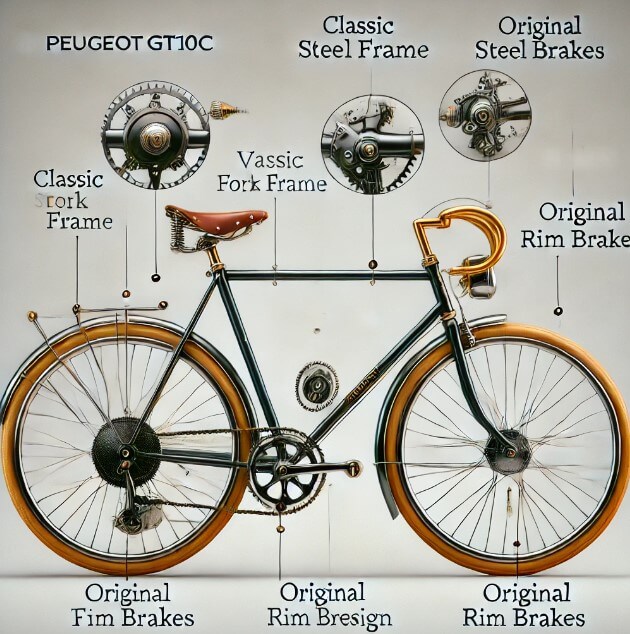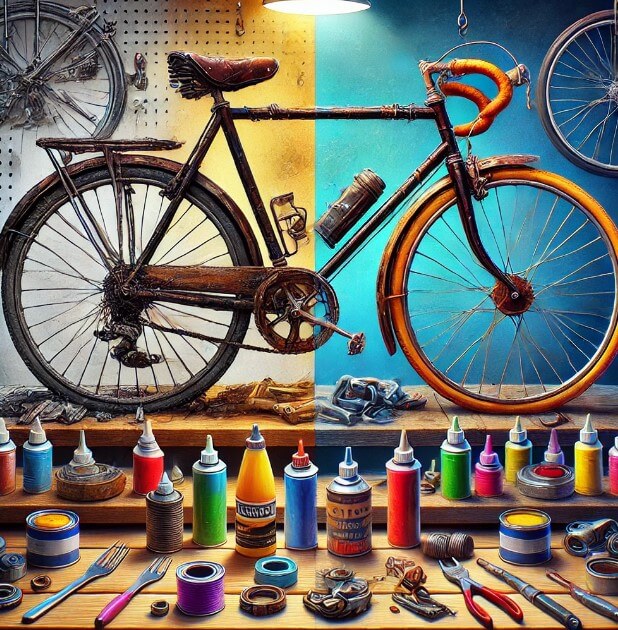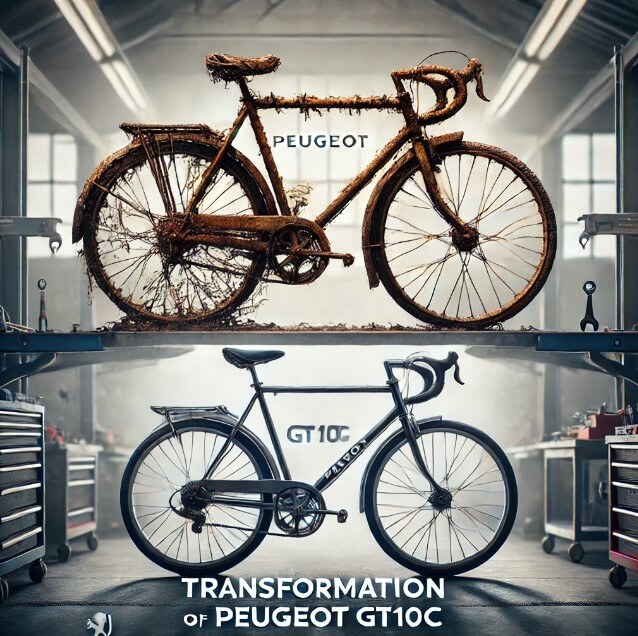The Peugeot GT10C is a classic bicycle that has captured the hearts of cycling enthusiasts and collectors worldwide. Known for its vintage charm and reliable performance, this model represents a significant era in cycling history. Transforming a Peugeot GT10C involves restoring its original features while incorporating modern enhancements to improve functionality and comfort. This guide provides a detailed, step-by-step approach to achieving a successful transformation of the Peugeot GT10C.
Restoring and transforming a vintage bicycle like the Peugeot GT10C is a rewarding endeavor that combines appreciation for classic design with the desire for modern performance. This guide aims to assist enthusiasts in navigating the transformation process, ensuring that the final result is both aesthetically pleasing and functionally superior.
Understanding the Peugeot GT10C
History and Significance
The Peugeot GT10C emerged during the mid-20th century, a period when Peugeot was renowned for producing high-quality bicycles that appealed to both casual riders and competitive cyclists. The GT10C model, in particular, was celebrated for its durability and elegant design, making it a sought-after choice among cycling aficionados.
Key Features

- Frame Material: The GT10C features a steel frame known for its strength and ability to absorb road vibrations, contributing to a comfortable ride.
- Fork Design: Equipped with the Fourche Peugeot GT10C fork, this component enhances stability and steering precision.
- Drivetrain: Originally fitted with a simple yet effective gear system suitable for various terrains.
- Braking System: Utilized traditional rim brakes, providing adequate stopping power for its time.
Planning the Transformation
Setting Objectives
Before commencing the transformation, it’s essential to define clear objectives. Determine whether the goal is to restore the bicycle to its original condition, upgrade it with modern components, or achieve a blend of both. This clarity will guide decision-making throughout the process.
Budgeting
Establishing a budget is crucial. Consider costs for:
- Replacement parts
- Specialized tools
- Professional services (e.g., painting, welding)
- Miscellaneous expenses (e.g., shipping, unforeseen repairs)
Sourcing Parts and Materials

Authentic parts can be sourced from:
- Vintage bicycle shops
- Online marketplaces
- Cycling forums and communities
Ensure that components are compatible with the GT10C’s specifications to maintain integrity and performance.
Disassembly and Inspection
Tools Required
- Allen wrenches
- Screwdrivers
- Bottom bracket tool
- Chain tool
- Pliers
- Rubber mallet
Step-by-Step Disassembly
- Remove Wheels: Release the quick-release levers or axle nuts and detach the wheels.
- Detach Brakes: Unhook brake cables and remove brake calipers.
- Remove Drivetrain Components: Take off pedals, crankset, chain, and derailleurs.
- Handlebars and Stem: Loosen bolts and slide out the handlebars and stem.
- Seat and Seatpost: Release the seatpost clamp and remove the seat and post.
- Bottom Bracket: Use the bottom bracket tool to unscrew and remove the bottom bracket.
Assessing Components
Inspect each part for:
- Signs of wear or damage
- Rust or corrosion
- Structural integrity
Decide which components can be restored, need replacement, or require upgrading.
Frame Restoration

Cleaning and Rust Removal
- Cleaning: Use a degreaser to remove dirt and grease.
- Rust Removal: Apply rust remover or use fine-grit sandpaper to eliminate rust spots.
Repairing Damages
- Dents: Minor dents can be addressed by a professional frame builder.
- Cracks: Welding may be necessary for structural cracks; consult a specialist.
Repainting Techniques
- Preparation: Sand the frame to create a smooth surface.
- Priming: Apply a primer suitable for metal surfaces.
- Painting: Use high-quality paint, applying multiple thin coats.
- Finishing: Seal with a clear coat for protection and shine.
Fork Restoration
Importance of the Fork
The fork is vital for steering and stability. The Fourche Peugeot GT10C fork is renowned for its durability and design, contributing significantly to the bike’s handling characteristics.
Restoration Process
- Inspection: Check for bends, cracks, or rust.
- Cleaning: Remove rust and old paint.
- Alignment: Ensure the fork is straight; professional assistance may be required.
- Painting: Follow the same steps as frame painting to restore its appearance.
Upgrading Components
Drivetrain Enhancements
- Crankset: Consider modern cranksets for improved efficiency.
- Derailleurs: Upgrade to contemporary derailleurs for smoother shifting.
- Chain: A new chain ensures reliability and longevity.
Brake System Upgrades
- Brake Calipers: Modern calipers offer better stopping power.
- Brake Levers: Ergonomically designed levers enhance comfort and control.
- Cables and Housing: New cables reduce friction and improve responsiveness.
Wheel and Tire Selection
- Wheels: Lightweight, durable wheels can enhance performance.
- Tires: Choose tires that suit your intended use, whether for commuting, touring, or sport.
Reassembly
Aligning Components
- Frame and Fork: Ensure proper alignment to maintain handling characteristics.
- Drivetrain: Align derailleurs and chainrings for smooth shifting.
- Brakes: Position calipers correctly for optimal braking performance.
Torque Specifications
Adhere to manufacturer-recommended torque settings to prevent over-tightening or under-tightening, which can lead to component failure or safety issues.
Safety Checks
- Brake Functionality: Test for responsiveness and stopping power.
- Steering: Ensure smooth and free movement without play.
- Wheel Attachment: Verify that wheels are securely fastened and true.
Final Adjustments and Testing
Gear and Brake Tuning
- Gears: Adjust derailleurs for precise shifting across all gears.
- Brakes: Fine-tune calipers and levers for optimal performance.
Test Riding
Conduct a test ride to ensure everything functions as intended. Pay attention to how the bicycle handles, shifts gears, and brakes. During this test ride, also observe the bike’s overall feel and make sure it provides a comfortable and smooth experience.
Making Necessary Adjustments
If you notice any issues during the test ride, take the time to make further adjustments. Common adjustments may include:
- Brake Tuning: Tighten or loosen brake cables for better responsiveness.
- Gear Alignment: Realign derailleurs for smoother gear changes.
- Seat and Handlebar Positioning: Adjust these for optimal riding comfort.
Maintenance Tips
To keep your Peugeot GT10C in excellent condition, follow a regular maintenance routine:
Regular Inspections
- Check Tire Pressure: Maintain the recommended tire pressure for optimal performance.
- Brake Pads and Cables: Inspect for wear and replace when necessary.
- Chain Lubrication: Lubricate the chain regularly to prevent rust and ensure smooth movement.
Cleaning and Lubrication
- Cleaning: Wipe down the frame and components with a soft cloth and bike cleaner to keep your bicycle looking pristine.
- Lubrication: Apply lubricant to moving parts such as the chain, derailleurs, and brake pivots to keep them running smoothly.
Storage Recommendations
- Indoor Storage: Store the bike indoors to protect it from harsh weather conditions that can cause rust and deterioration.
- Use a Bike Cover: If outdoor storage is necessary, use a waterproof cover to shield your bicycle from the elements.
Conclusion
Transforming a Peugeot GT10C is a project that combines passion for cycling, appreciation for classic design, and the desire to enhance performance with modern upgrades. By carefully planning and executing the transformation, you can create a unique and beautiful bicycle that performs well on today’s roads while paying homage to its historical roots. Whether you choose to restore the bike to its original glory or customize it to your needs, the process will be rewarding and fulfilling.
FAQs
1. What is the Peugeot GT10C known for?
The Peugeot GT10C is known for its classic design, durable steel frame, and reliable performance. It is a sought-after vintage bicycle that appeals to both collectors and cycling enthusiasts.
2. Where can I find original parts for the Peugeot GT10C?
You can find original parts from vintage bicycle shops, online marketplaces, and cycling communities. Be sure to verify the compatibility of the parts with the GT10C model.
3. How do I remove rust from the frame and components?
To remove rust, use a rust remover or fine-grit sandpaper. For stubborn rust spots, you may need to use a wire brush or consider professional assistance for extensive rust removal.
4. What are some recommended upgrades for the Peugeot GT10C?
Recommended upgrades include modern brake systems for better stopping power, an updated drivetrain for smoother shifting, and lightweight wheels to improve performance. Ergonomic handlebars and a more comfortable saddle are also great enhancements.
5. How often should I service my transformed Peugeot GT10C?
Regular servicing is essential. Perform a thorough inspection every few months, especially if you ride frequently. Clean and lubricate moving parts regularly, and replace worn components as needed.
6. Can I customize the paint job on my Peugeot GT10C?
Yes, you can customize the paint job. Just ensure that you prepare the frame properly, use high-quality paint, and apply a protective clear coat to extend the paint’s life. Custom paint jobs can add a unique and personalized touch to your bike.
Visit Globeya.com for more!



